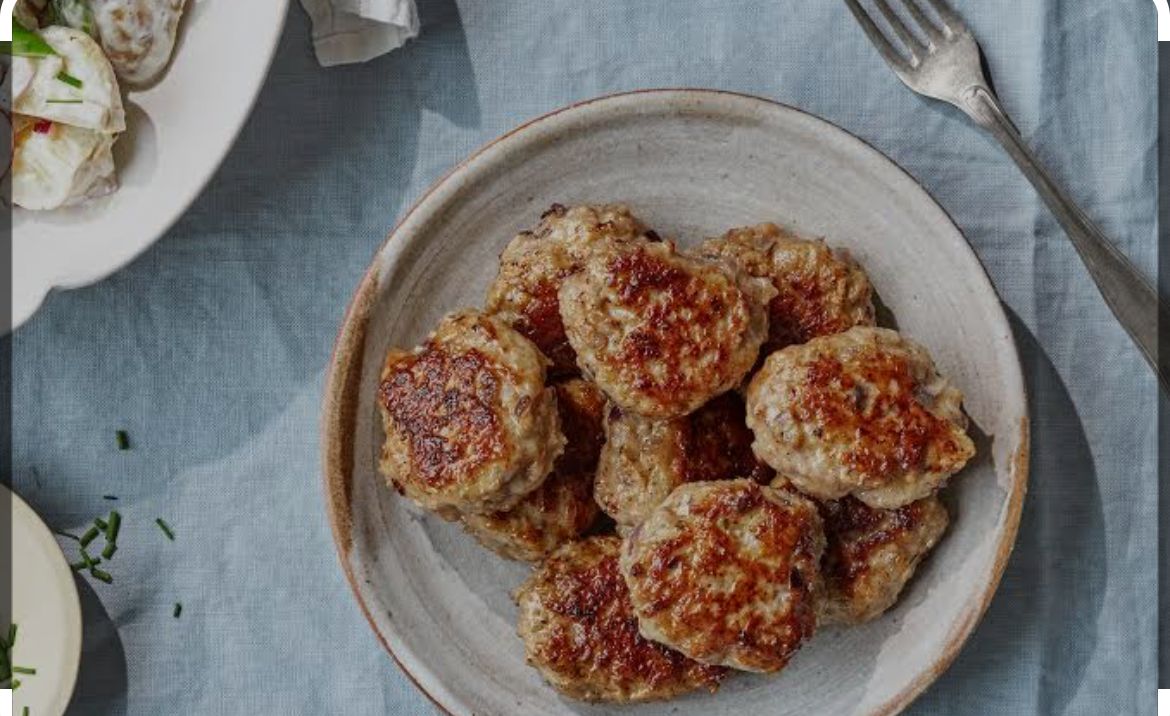Traditional Danish Recipe: Frikadeller (Danish Meatballs)
Looking for a taste of Danish food that will transport you to the streets of Copenhagen? Try Frikadeller, the beloved Danish meatballs that are a staple in every Danish household.
Made with a mixture of ground pork and beef, breadcrumbs, onions, and spices, these flavorful meatballs are pan-fried to perfection. The result is a juicy and tender dish that pairs perfectly with creamy mashed potatoes and lingonberry jam.
Whether you’re hosting a festive gathering or simply craving comfort food on a chilly evening, Frikadeller is the perfect choice. Serve them as an appetizer or as the main course for a cozy Danish recipe experience like no other.
Recipe: Danish Frikadeller (Danish Meatballs)
Ingredients:
- 500g minced pork
- 1 onion, finely chopped
- 1 egg
- 4 tablespoons of flour
- Salt and pepper to taste
- A pinch of nutmeg
- Butter for frying
Preparation time: 15 minutes
Serves: 4 persons
Cooking time: 20 minutes
Difficulty score: 3 out of 10
The difficulty score is relatively low because the recipe involves simple ingredients and basic cooking techniques. As long as you pay attention to the details, it should be easy to achieve delicious results.
Note: In Denmark, Frikadeller are commonly served with boiled potatoes, red cabbage, and gravy.
Instructions:
- In a large bowl, mix together the minced pork, chopped onion, egg, flour, salt, pepper, and nutmeg until well combined.
- To test the seasoning of the mixture, fry a small amount in a hot pan and adjust salt and pepper if needed.
- In a non-stick pan over medium heat, melt butter for frying.
- To form the meatballs, wet your hands slightly with water to prevent sticking. Take a spoonful of the mixture and shape it into a round ball. Flatten slightly to create a disc-shaped meatball.
- Fry the Frikadeller in batches for about 4-5 minutes on each side or until golden brown and cooked through. Make sure not to overcrowd the pan to ensure even browning.
- Serve hot with boiled potatoes, red cabbage, gravy or your favorite side dishes. Enjoy these traditional Danish meatballs!
Nutrition: Frikadeller (Danish Meatballs)
Frikadeller, also known as Danish Meatballs, is a classic Danish recipe that is loved for its savory flavors and comforting taste. While it may not be the healthiest dish due to its high fat content, when enjoyed in moderation, it can be a delicious treat for special occasions.
Here is the nutrition per serving based on the traditional recipe for Frikadeller:
- Calories: 250
- Total Fat: 18g
- Saturated Fat: 6g
- Cholesterol: 80mg
- Sodium: 400mg
- *Nutrition values are approximate and may vary based on ingredients used.
While Frikadeller may not be the healthiest choice for everyday meals, it can be enjoyed as an occasional indulgence in a balanced diet. Pairing these Danish Meatballs with a side of steamed vegetables or a fresh salad can help balance out the meal and add some extra nutrients.
So go ahead and savor the flavors of this classic Danish food, but remember to enjoy it in moderation for a well-rounded approach to your diet!
Serving suggestions for Frikadeller (Danish Meatballs)
If you are looking to serve Frikadeller (Danish Meatballs) in a traditional Danish manner, consider pairing them with kartoffelsalat (potato salad), rødkål (red cabbage), and brun sovs (brown gravy). This classic combination of flavors and textures is sure to please your taste buds.
- Kartoffelsalat: A creamy and savory potato salad that complements the rich flavors of the meatballs.
- Rødkål: Sweet and tangy red cabbage that adds a pop of color and freshness to the dish.
- Brun sovs: A flavorful brown gravy that ties everything together with its richness and depth of flavor.
You can also serve Frikadeller with a side of rødgrød med fløde, a traditional Danish dessert made from red berries cooked into a thick pudding-like consistency, topped with cream. This sweet treat is the perfect way to end your meal on a high note.
What to serve with Frikadeller (Danish Meatballs)
In addition to the traditional Danish sides mentioned above, there are plenty of other options for what to serve with Frikadeller. Consider pairing these delicious meatballs with some roasted vegetables, such as roasted carrots, brussels sprouts, or sweet potatoes. The caramelized flavors of the roasted veggies will complement the savory meatballs perfectly.
- Roasted Carrots: Sweet and tender carrots that add a pop of color and sweetness to your meal.
- Brussels Sprouts: Crispy brussels sprouts that offer a nice contrast in texture to the soft meatballs.
- Sweet Potatoes: Creamy and flavorful sweet potatoes that provide a hearty accompaniment to the dish.
To round out your meal, consider serving some crusty bread or boiled new potatoes on the side. The bread is perfect for soaking up any leftover gravy, while the new potatoes offer a simple yet satisfying starch option. Enjoy your Danish feast!
Tips for Enhancing the Flavor of Frikadeller (Danish Meatballs)
If you want to elevate the taste of your Danish recipe for Frikadeller (Danish Meatballs), here are some tips to enhance the flavor:
1. Use a mixture of ground pork and beef for a more complex flavor profile.
2. Add finely chopped onions and garlic to the meat mixture for added depth.
3. Season generously with salt, pepper, and spices like nutmeg and allspice.
4. For a touch of sweetness, add a splash of milk or cream to the meat mixture.
5. Fry the meatballs in butter for a rich and indulgent flavor.
Spicy Score: 3 out of 10
I would give these Frikadeller a spicy score of 3 out of 10. While traditional Danish cuisine is not known for being spicy, you can still add a hint of heat by incorporating ingredients like black pepper or chili flakes. However, be mindful not to overpower the delicate flavors that make Danish food so unique.

